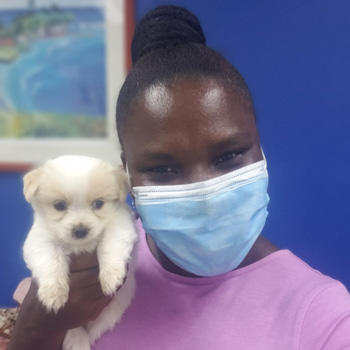 Read on for his thoughts on preventing diabetes in pets, why he chose RUSVM, and the amazing way one client expressed her gratitude after Dr. Della Ripa saved her pet’s life.
Read on for his thoughts on preventing diabetes in pets, why he chose RUSVM, and the amazing way one client expressed her gratitude after Dr. Della Ripa saved her pet’s life.
What’s a typical day like for you?
I’m an internal medicine specialist at MedVet Medical and Cancer Center in Cincinnati, where I see both appointments and emergencies. There are patients that range from chronic sneezing to multi-organ failure. Although not an exhaustive list, the common conditions we treat include kidney failure; inflammatory bowel disease; endocrine diseases such as diabetes; liver failure; pancreatitis; immune mediated, respiratory and infectious diseases.
What’s one of your most memorable patient experiences?
There was a truly special Jack Russell Terrier Mix named Rocket that I used to treat. He had so many issues going on throughout his life, including pancreatitis, Cushing’s, diabetes and recurrent urinary tract infections, but he always maintained a fantastic attitude, and was such a lovable creature.
I saved his life when he was in a pancreatic crisis. From that point forward, Rocket’s mother cooked me a full homemade dinner—five courses!—and brought it to the clinic herself every Friday for almost a year. She is now a close friend of mine, and forever will be, even though Rocket has passed.
Why did you choose RUSVM for veterinary school?
I was a great student and hardworking but wasn’t at the top of my class. My experience and grades were not competitive enough to get into a U.S. veterinary institution. That was when I started to research RUSVM. The more I learned about the school and spoke with students and graduates, the more I realized how special it was. The loyalty of students and graduates was through the roof and that excited me.
RUSVM was tough, but it was a great experience that I will hold with me forever, and which I utilize every day when I treat patients like Rocket. It gave me a chance to focus 100 percent on immersing myself into the veterinary field.
How did you come to specialize in internal veterinary medicine?
I completed a rotating internship at at MedVet Mandeville in Louisiana after graduating from RUSVM. My mentor, Dr. Kenny Arceneaux, was passionate about the internal medicine field, and that passion was contagious. This was where I learned to enjoy the challenge of diagnosing and treating internal medicine patients.
How prevalent is diabetes in pets? Are certain animals more prone to it?
Diabetes is by far one of the most common diseases I see. About one out of 500 dogs and one out of 250 cats develops diabetes. Samoyed and terrier dogs are predisposed to the condition, as well as Burmese cats. However, all dogs and cats can get diabetes.
What are the risk factors for developing diabetes?
The disease is usually multifactorial, but can develop without an underlying cause. Risk factors are obesity (more commonly cats), pancreatitis, hyperlipidemia (more commonly dogs), Cushing’s disease, corticosteroid usage, and acromegaly (more commonly cats).
How is the condition diagnosed and treated?
Diagnosis is based on symptoms of excessive thirst and urination, weight loss, the presence of hyperglycemia and glucosuria.
Treatment includes once to twice daily long-acting insulin injections in both dogs and cats. Cats can occasionally be managed with just a change in diet (high protein, low carbohydrate) if the hyperglycemia is mild. Dog and cats that are in a crisis (“ketoacidosis”) requires hospitalization and aggressive care, as the condition can be life-threatening. Management of any secondary diseases such as pancreatitis or Cushing’s is also recommended to further reduce a patient’s insulin needs.
How can pet owners reduce the risk of their pets developing the condition?
The best thing you can do is to prevent obesity. For cats, we suspect feeding them a high-protein, low-carb wet food helps to reduce the risk of diabetes. Dry foods are not ideal for cats, as they are higher in carbohydrates and can contribute to obesity.
Any misconceptions about pet diabetes that owners should know?
Pet owners, especially if they are diabetics themselves, tend to get worried during the regulation process when their pet’s blood glucoses are not “normal” despite insulin therapy. It’s important to remember that there’s a fundamental difference between human and pet diabetes. Humans live with diabetes for 30 years or longer and require very tight regulation to prevent long-term complications, such as atherosclerosis. But since cats and dogs don’t live as long as humans, these long-term complications aren’t seen as frequently. Therefore, our goal is to always maximize quality of life and not be too aggressive with insulin therapy, as overdoses of insulin can make dogs and cats extremely ill.
Any advice for students considering a career in internal veterinary medicine?
The field of internal medicine is tough. Work hours are long, patients can be difficult to manage and often very ill, and the prognosis is almost always guarded. However, the field can be very rewarding, as you’re treating some of the most challenging diseases and have the opportunity to meet very dedicated owners.







